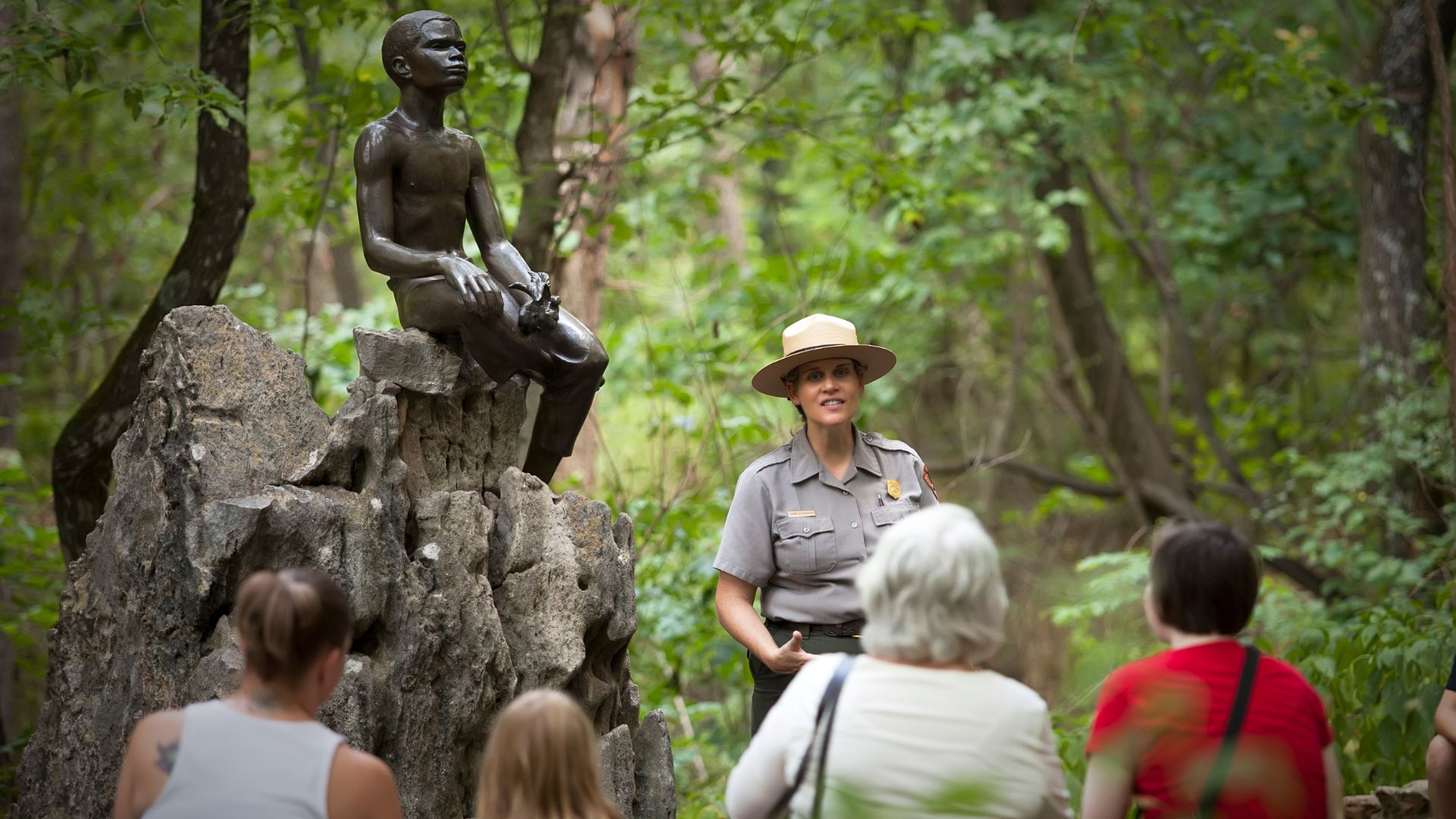From Florida to Alaska, park rangers help visitors enjoy the amazing U.S. national parks.
September 2018

A park ranger conducts a guided tour along the Carver Trail at the George Washington Carver National Monument in Missouri. (Courtesy National Park Service)
What do all U.S. national parks have in common? Natural beauty and rich heritage, of course, as well as a welcoming spirit for travelers who come from around the world.
Perhaps less obvious, though, is the nationwide network of dedicated park rangers, who guarantee that all the state and national parks in the United States stay in pristine condition, and that visitors of all ages have an amazing time experiencing them.
According to the National Park Foundation, there are 417 national parks across the United States, ranging from the desert beauty of Canyonlands National Park in Utah to the lush mountains of Great Smoky Mountains National Park in North Carolina and Tennessee, and the stunning geysers of Yellowstone National Park in Wyoming to the majestic portraits of past presidents carved into stone at Mount Rushmore in South Dakota. Unique and beautiful, each of these parks is maintained, preserved and patrolled by its own team of expert park rangers.
The rangers, who can often be instantly recognized by their earth-tone uniforms and hats, fulfill a wide variety of roles at national parks. They serve as law enforcement officers, environmental experts, historians or a combination of the three. Many of them also focus their efforts on providing park-specific information to visitors, whether that means answering questions about weather advisories and hiking directions or providing information on local wildlife, plants and trees. They often lead guided tours of natural and historic sites, and conduct presentations, demonstrations and even reenactments of historical events.

A park ranger dressed in period clothing for the Canal Day celebration at the Upper Delaware Scenic and Recreational River. (Courtesy National Park Service)
At Yellowstone National Park, for example, park rangers conduct a range of programs, including the Young Scientist Investigation. Visitors explore the park’s Upper Geyser Basin with rangers and learn about the science behind geysers like the world-famous Old Faithful, volcanoes and more. Similarly, travelers to Florida’s Everglades National Park can join park rangers and learn how to cast nets and catch saltwater fish off the coast of the Gulf of Mexico, or explore the picturesque Ten Thousand Islands in a canoe. Daniel Agudelo, a 24-year-old ranger at the park, became interested in the job due to his love for the outdoors and teaching. To him, the most important roles that park rangers play are to serve as a bridge between a park and an explorer, enhance visitors’ experiences and teach them new things. And, that’s just the beginning.
Beyond these fun, educational programs, park rangers’ key duties include protecting visitors. A portion of them, called law enforcement rangers, go through rigorous training before becoming official federal officers. They make sure that both local and national laws are followed within national parks, and respond immediately to crimes or incidents within park borders.
While park rangers work hard to establish U.S. national parks as safe places for learning, relaxation and adventure for visitors, accidents can happen. Luckily, they are equipped to respond to nearly any problem that might occur.
Many of them have special expertise in wilderness emergency medicine and can help visitors with issues ranging from scrapes and bruises to animal bites, broken bones and heart attacks. Highly-trained park rangers direct and execute emergency search and rescue missions in situations where explorers get lost or injured. They are also trained to spot fires, which can often be a serious threat in national parks, and help deal with them quickly and effectively.
Park rangers come from a wide variety of geographic, educational, cultural and professional backgrounds, but have a few important things in common: A love for the outdoors and a desire to share and inspire through the wonders of U.S. national parks. Take for instance Betty Reid Soskin, who works at the Rosie the Riveter/World War II Home Front National Historical Park in Richmond, California. At age 96, she is the oldest serving park ranger with the National Park Service in the country. She proudly wears her ranger uniform on and off the job, “because when I’m on the streets or on an escalator or elevator, I am making every little girl of color aware of a career choice she may not have known she had,” she said in an interview to the U.S. Department of the Interior in 2015.
“What makes a great ranger,” says Agudelo, “is someone who sees a silly question not as a bother, but as a blessing and an opportunity to interact.” He sees visitors who are inspired with new knowledge as de facto ambassadors—“rangers” in their own right—who will then educate others about their amazing experiences in national parks.
For Agudelo, working with the National Park Service is a true calling. “How long do I expect to continue as a ranger? Until I am kicked out!” he jokes. “Seriously, I really support the National Park Service’s mission and see myself rising up in the ranks. I want to grow old with this park, and this agency.”
Michael Gallant is the founder and chief executive officer of Gallant Music. He lives in New York City.
COMMENTS